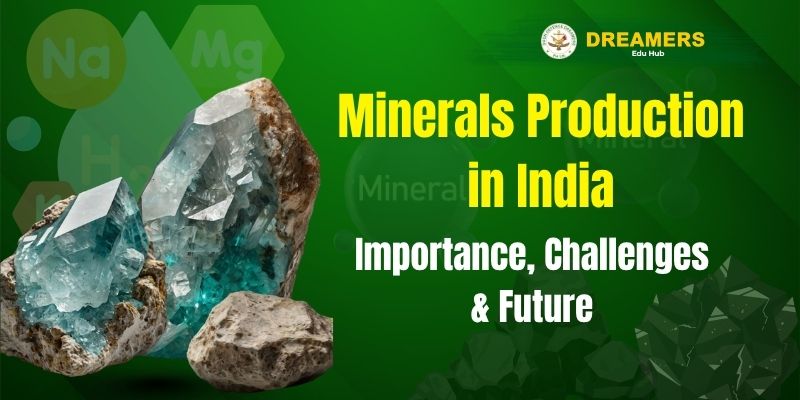Minerals are naturally occurring substances found in the earth’s crust, with definite chemical composition and physical properties. They form the basic raw material for almost every industry – steel, cement, power, transport, electronics, defence and even daily household items. Without minerals, there would be no buildings, no electricity, no vehicles and no modern infrastructure.
Because of this, Minerals Production in India plays a crucial role in shaping the country’s growth story. From iron ore that feeds steel plants to coal that powers thermal stations, minerals silently support factories, jobs and development across the nation.
Role of Minerals in India’s Economy and Development
India is an emerging industrial and services power, but the backbone of this growth still depends heavily on mining and minerals. The mining sector contributes to GDP, provides employment in remote regions, supports railways and ports through freight, and supplies raw materials to core industries.
States such as Jharkhand, Odisha, Chhattisgarh and Karnataka earn a significant part of their revenue from royalties and premiums linked to Minerals Production in India. Proper use of these resources can reduce import dependence, support “Make in India” manufacturing, and create balanced regional development in mineral-rich but otherwise underdeveloped areas.
Major Minerals Produced in India
Metallic Minerals (Iron Ore, Bauxite, Copper, etc.)
Metallic minerals contain metals in raw form and become the foundation for the heavy industries. In the context of Minerals Production in India, the major metallic minerals are:
Iron ore – essential for steel. India is among the leading producers, with large deposits in Odisha, Jharkhand, Chhattisgarh and Karnataka.
Bauxite – the ore of aluminium, important for transport, packaging and aerospace. Major deposits lie in Odisha, Jharkhand, Gujarat and Maharashtra.
Manganese – used in steel-making and battery industries, produced mainly in Odisha, Karnataka and Maharashtra.
Copper ore – important for electrical and electronics industries; India has smaller reserves, with production in Rajasthan, Madhya Pradesh and Jharkhand.
These metallic minerals determine how fast India can expand steel capacity, aluminium smelting and allied sectors, without over-reliance on imports.
Non-Metallic Minerals (Limestone, Mica, Gypsum, etc.)
Non-metallic minerals do not contain metals but are equally vital. In Minerals Production in India, the key non-metallic minerals include:
Limestone, used mainly in cement and steel plants, widely found in Madhya Pradesh, Rajasthan, Andhra Pradesh and Gujarat.
Mica, once a major export item, with high-quality mica from Jharkhand and Bihar regions.
Gypsum, used in cement and fertilizer, found in Rajasthan and some parts of Jammu & Kashmir.
Dolomite, quartz, feldspar and other industrial minerals, supplying glass, ceramics, refractories and chemical industries.
Non-metallic minerals appear simple, but their availability and cost directly affect housing, construction and infrastructure projects.
Energy Minerals (Coal, Lignite, Uranium – brief mention)
Energy minerals power homes, offices and factories. In Minerals Production in India, the leading energy minerals are:
Coal, the dominant fuel for electricity generation, with big reserves in Jharkhand, Odisha, Chhattisgarh, West Bengal and Madhya Pradesh.
Lignite, a softer form of coal, occurring mainly in Tamil Nadu and Gujarat.
Uranium, used as fuel in nuclear power plants, with deposits in Jharkhand, Andhra Pradesh and Meghalaya.
These minerals decide energy security and influence everything from power tariffs to industrial competitiveness.
Top 3 Countries in Production of Key Minerals
Top 3 countries in the production of key minerals largely decide the direction of the global raw-material market. For iron ore, Australia, Brazil and China together supply a major share of what the world’s steel plants need. In coal, China, India and the United States dominate, making energy security closely tied to their mining policies and output levels. Bauxite mainly comes from Australia, China and Guinea, while copper is led by Chile, Peru and the Democratic Republic of Congo. In manganese, South Africa, Australia and Gabon are the main contributors.
| Mineral | Top 3 Producing Countries (approx.) |
|---|---|
| Iron ore | Australia, Brazil, China |
| Coal | China, India, United States |
| Bauxite | Australia, China, Guinea |
| Copper | Chile, Peru, DR Congo |
| Manganese | South Africa, Australia, Gabon |
India’s Position in World Minerals Production
Globally, a few countries dominate production of key minerals. In many cases, India figures within the top 5 or top 10. For example, in coal and iron ore, Minerals Production in India holds an important position, while in bauxite and manganese, India is a significant but not leading producer.
At the same time, some minerals like copper, crude oil and high-grade coking coal are not available in sufficient quantity domestically, forcing India to depend on imports. Understanding where India stands compared to other countries helps in planning long-term strategies.
Comparison of India with Top Producers
The table below gives a broad picture of top producers for selected minerals, along with the country holding the maximum known reserves and the approximate position of India.
| Mineral | Top 3 Producing Countries (Approx.) | Country with Largest Known Reserves | India’s Position (Broad View) |
|---|---|---|---|
| Iron ore | Australia, Brazil, China | Australia | Among top 5 producers |
| Coal | China, India, United States | United States / Russia / Australia | 2nd largest producer |
| Bauxite | Australia, China, Guinea | Guinea | Among top 5 producers |
| Copper | Chile, Peru, DR Congo | Chile | Smaller producer, imports significant |
| Manganese | South Africa, Australia, Gabon | South Africa | Important producer but not top 3 |
These rankings may slightly change with time, but they show that Minerals Production in India is strong in some areas (coal, iron ore, bauxite) and relatively weaker in others (copper, high-grade ore, certain critical minerals).
Countries with Maximum Mineral Reserves for Selected Minerals
Reserves indicate how long production can continue at current or higher rates. In many cases, the countries with maximum reserves act as long-term resource powers. For example:
Coal reserves are highest in the United States, Russia and Australia, while India also has large deposits.
Iron ore reserves are substantial in Australia, Brazil and Russia.
Bauxite reserves are very large in Guinea, followed by Australia and Vietnam.
For planners in India, these facts matter because future trade, supply security and price stability will depend on both Minerals Production in India and the reserve strength of partner countries.
State-wise Distribution of Minerals in India
Major Mineral-Rich States (Jharkhand, Odisha, Chhattisgarh, etc.)
Within India, minerals are not evenly spread. A few states account for most of the production. Jharkhand, Odisha and Chhattisgarh form the core of India’s mineral belt, with rich deposits of coal, iron ore and bauxite. Karnataka and Goa are important for iron ore; Rajasthan for limestone, gypsum and non-metallic minerals; Gujarat for lignite and bauxite; and Andhra Pradesh, Telangana and Madhya Pradesh for a mix of metallic and non-metallic minerals.
This uneven spread means that Minerals Production in India has a strong regional character, with certain states acting as “mineral powerhouses” that support the rest of the country.
Region-wise Mineral Belt of India (North-Eastern, Central, Southern)
Broadly, India’s mineral regions can be grouped as:
The Eastern–Central Belt, covering Jharkhand, Odisha, Chhattisgarh and parts of West Bengal and Madhya Pradesh, rich in coal, iron ore and bauxite.
The Southern Belt, including Karnataka, Andhra Pradesh, Telangana and Tamil Nadu, with iron ore, manganese, bauxite and limestone.
The Western–Northwestern Belt, mainly Rajasthan and Gujarat, known for non-metallic minerals like limestone, gypsum, lignite and industrial minerals.
These belts show where Minerals Production in India is naturally concentrated, guiding location decisions for steel plants, cement factories and power stations.
Table Showing Minerals and Their Leading States
A simple view of important minerals and leading states is given below:
| Mineral | Leading Indian States (Main Examples) |
|---|---|
| Coal | Jharkhand, Odisha, Chhattisgarh, West Bengal, Madhya Pradesh |
| Iron ore | Odisha, Jharkhand, Chhattisgarh, Karnataka, Goa |
| Bauxite | Odisha, Gujarat, Jharkhand, Maharashtra, Andhra Pradesh |
| Limestone | Rajasthan, Madhya Pradesh, Andhra Pradesh, Gujarat, Chhattisgarh |
| Manganese | Odisha, Karnataka, Madhya Pradesh, Maharashtra |
| Mica | Jharkhand, Bihar (region of old mica belt) |
This pattern helps explain why heavy industries cluster near certain states: proximity to mines reduces transport cost and supports large-scale Minerals Production in India.
Challenges in Minerals Production in India
Environmental Issues and Land Degradation
Mining often takes place in forested or ecologically sensitive areas. Open-cast mines can cause deforestation, soil erosion, dust, noise and disturbance to local wildlife. If not managed properly, mining spoils land, contaminates water bodies and affects agriculture and traditional livelihoods.
Balancing Minerals Production in India with environmental protection is a major challenge. Strict environmental clearances, scientific mine planning, progressive mine closure and rehabilitation of mined-out areas are necessary to reduce long-term damage.
Illegal Mining, Safety and Labour Concerns
Illegal mining and unregulated extraction create multiple problems: loss of government revenue, exploitation of workers, unsafe working conditions and serious accidents. Small, unscientific mines may not follow proper safety rules, leading to mine collapses, toxic gas exposure and other hazards.
Improving Minerals Production in India requires strong enforcement against illegal operations, training for workers, better safety equipment and regular inspections. Human life and dignity must remain more important than mere output numbers.
Need for Technology, Sustainability and Regulation
In many places, mining still uses older technology with low productivity and high wastage. Modern equipment, automation, digital mapping and remote sensing can make Minerals Production in India more efficient and less harmful. At the same time, clear and stable policies are required so that investors, public sector companies and local communities know their rights and responsibilities.
Sustainable mining means using resources wisely, avoiding over-extraction, protecting the environment and ensuring that mineral wealth benefits local populations through jobs, schools, healthcare and basic infrastructure.
Future of Minerals Production in India
Government Policies, Auctions and Reforms
In recent years, several reforms have been introduced to bring transparency into Minerals Production in India. Mining leases are increasingly granted through auctions, which helps states gain higher revenues and reduces the scope for arbitrary allotment. Policy changes under the Mines and Minerals (Development and Regulation) Act aim to simplify procedures, encourage exploration and attract investment.
At the same time, district mineral foundations (DMFs) have been created to use a part of mining revenue for the welfare of affected areas. If implemented well, these measures can make mining more inclusive and balanced.
Scope for Value Addition and Exports
India exports raw minerals like iron ore and bauxite, but the real value lies in converting ores into finished products such as steel, aluminium, alloys and specialised chemical products. Developing downstream industries around mining clusters can create more jobs and bring higher revenue than exporting raw material alone.
With proper infrastructure, research and skill development, Minerals Production in India can support high-quality exports and integration into global value chains. This will not only earn foreign exchange but also strengthen India’s position as a reliable supplier of processed mineral-based products.
Minerals Production in India and the Path to Sustainable Growth
The future of Minerals Production in India depends on finding a balance between three key goals: economic growth, social justice and environmental protection. Minerals are finite; once extracted, they do not regenerate. Therefore, every decision taken today must keep future generations in mind.
By adopting modern technology, strong regulation, honest governance and community participation, India can turn its rich mineral base into a long-term asset. A smart and sustainable mining sector can fuel industries, generate employment, support infrastructure and still protect forests, rivers and local communities. In this way, minerals will continue to power India’s progress while keeping the foundation of development fair, green and resilient.
Doon Defence Dreamers on the Importance of Minerals Production in India
For Doon Defence Dreamers (the best CDS coaching in Dehradun), minerals production in India is not just a geography or economy topic; it is a pillar of national strength. Minerals like coal, iron ore, bauxite, manganese and limestone feed power plants, steel mills, cement factories, railways, ports and defence industries. When cadets study minerals production in India, they learn how coal from Jharkhand and Odisha keeps bases and cities powered, how iron ore from Chhattisgarh and Karnataka becomes armour, ships and aircraft parts, and how bauxite reserves support the aluminium needed in aviation and missiles.
The academy highlights that a country with strong mineral production reduces import dependence, saves foreign exchange and gains strategic independence in war and peace. By linking mines, industries, transport and defence, Doon Defence Dreamers helps aspirants understand that minerals production in India is directly connected to economic security, energy security and overall national security.





























